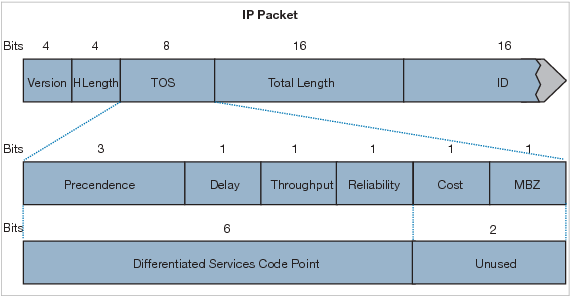Question 1
Explanation
The following diagram illustrates the key difference between traffic policing and traffic shaping. Traffic policing propagates bursts. When the traffic rate reaches the configured maximum rate (or committed information rate), excess traffic is dropped (or remarked). The result is an output rate that appears as a saw-tooth with crests and troughs. In contrast to policing, traffic shaping retains excess packets in a queue and then schedules the excess for later transmission over increments of time. The result of traffic shaping is a smoothed packet output rate.

Note: Committed information rate (CIR): The minimum guaranteed data transfer rate agreed to by the routing device.
Question 2
Question 3
Explanation
The IP datagram header contains an 8-bit field called ToS (Type of Service). The field has been part of the IP header since the beginning, but it was rarely used until the recent introduction of Differentiated Services (Diff-Serv).

Note:
+ CoS does not exists in an IP header. It appears in the header of a 802.1Q frame only. CoS is used for QoS on a trunk link.
+ DSCP uses the first 6 bits of the TOS field.
Question 4
Explanation
The Resource Reservation Protocol (RSVP) protocol allows applications to reserve bandwidth for their data flows. It is used by a host, on the behalf of an application data flow, to request a specific amount of bandwidth from the network. RSVP is also used by the routers to forward bandwidth reservation requests.
Question 5
Explanation
The following diagram illustrates the key difference between traffic policing and traffic shaping. Traffic policing propagates bursts. When the traffic rate reaches the configured maximum rate (or committed information rate), excess traffic is dropped (or remarked). The result is an output rate that appears as a saw-tooth with crests and troughs. In contrast to policing, traffic shaping retains excess packets in a queue and then schedules the excess for later transmission over increments of time. The result of traffic shaping is a smoothed packet output rate.

Note: Committed information rate (CIR): The minimum guaranteed data transfer rate agreed to by the routing device.
Question 6
Explanation
Layer-3 marking is accomplished using the 8-bit Type of Service (ToS) field, part of the IP header. A mark in this field will remain unchanged as it travels from hop-to-hop, unless a Layer-3 device is explicitly configured to overwrite this field. There are two marking methods that use the ToS field:
+ IP Precedence: uses the first three bits of the ToS field.
+ Differentiated Service Code Point (DSCP): uses the first six bits of the ToS field. When using DSCP, the ToS field is often referred to as the Differentiated Services (DS) field.

Reference: http://www.routeralley.com/guides/qos_classification.pdf
Question 7
Explanation
The following diagram illustrates the key difference between traffic policing and traffic shaping. Traffic policing propagates bursts. When the traffic rate reaches the configured maximum rate (or committed information rate), excess traffic is dropped (or remarked). The result is an output rate that appears as a saw-tooth with crests and troughs. In contrast to policing, traffic shaping retains excess packets in a queue and then schedules the excess for later transmission over increments of time. The result of traffic shaping is a smoothed packet output rate.
